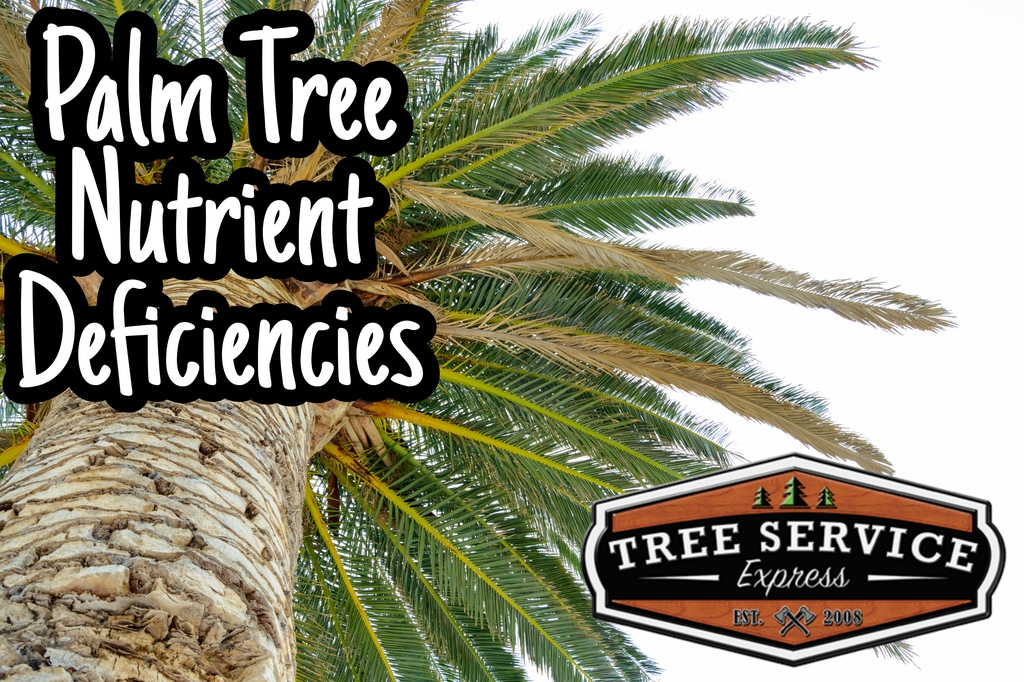Palm Tree Nutrient Deficiencies

Last month we reviewed palm tree diseases and infestations, this month we turn our attention to palm tree nutrient deficiencies. Just as people can suffer from various nutrient deficiencies, so can palm trees. Many are aware that the soil found in Brevard County, FL., like most of the soil in Florida is what some consider, “sandy soil”.
The soil lacks nutrients/micro-nutrients which serve as natural palm tree fertilizer. Tree Service Express is here to offer various tree services and lend our expertise in palm tree care despite Florida’s nutrient-poor soil.
Let’s review a few of the most common nutrients palm trees in our area require, what deficiencies look like, and what you can do about the issue.
Nutrient Deficiencies
• Potassium (K) - One of the most common nutrient deficiencies found in palms is potassium deficiency. Depending on the species, symptoms can present differently but usually appear on the older fronds first. Signs of this deficiency can include discoloration (dull yellow appearance), yellow/orange-like necrotic streaks or spots, death of the tips of the fronds and more. If the tips of the fronds are dying/dead the lower fronds can look brown and tattered. Once this takes place, it can be confused for a Manganese deficiency. Our experts can tell the difference during a proper assessment.
• Nitrogen (N) - Palms that lack nitrogen can show symptoms like other deficiencies, like discoloration/yellowing. However, with a nitrogen deficiency the coloring will appear uniformly across the surface of the fronds as opposed to specific areas (like just the tips) commonly seen with other nutrient deficiencies.
• Manganese (Mn) - This type of deficiency typically occurs in new fronds/leaves and is commonly referred to as “frizzle-top”. The ends of the fronds can appear curled, crinkled or stunted. Additionally, they can grow looking weak, chlorotic, reduced in size with extensive streaking. Manganese deficiency is the result of soil that is too alkaline.
• Magnesium (Mg) - Another common deficiency for Florida palms, this deficiency is characterized by a broad light-yellow band along the margin of the leaves/fronds with a green center. The yellowing can appear first on the older fronds and progresses onto the newer fronds. While this type of deficiency isn’t fatal to the tree, it will affect the look of the tree. In severe cases, the tips of the fronds can turn brown because of dying tissue. Date palms are the most susceptible to Mg deficiency.
• Boron Deficiency - Boron deficiency is less common than other types of deficiencies but is still a very real issue to Brevard County palms. It causes a wide array of symptoms that occur on newly emerging palms and remain visible on the fronds as they age. The fronds will appear crumpled or can cause a severe bend in the tips, commonly known as ‘hook-leaf’. It can also present as transverse translucent streaking or puckering of the leaflets.
• Iron Deficiency - Iron (Fe) deficiency can appear as interveinal or uniform chlorosis of the newest leaves, while the older leaves remain green. In severe cases, new leaflets can have necrotic tips and growth will be stunted. These symptoms can be confused with other palm tree issues, especially in royal palms (royal palm bug damage) because both result in general chlorosis of the spear and youngest leaf. We can help differentiate between deficiencies, diseases, and infestations.
Unfortunately, once a palm on your Brevard County property is affected, it will continue to progress until the tree is dead or is removed. Once a deficiency is diagnosed and corrected, new leaves/fronds can emerge, and the tree will become healthier. Almost all nutrient deficiencies can be corrected.
Keep in mind, there are ordinances in place regarding the use of fertilizers. You can find some ordinance information here. If you’re worried one or more palms on your residential or commercial property is suffering from a nutrient deficiency, don’t worry! Give the experts of Tree Service Express a call or fill out our contact form here. We look forward to working with you and getting to the ‘root’ cause of your palm tree issues.
